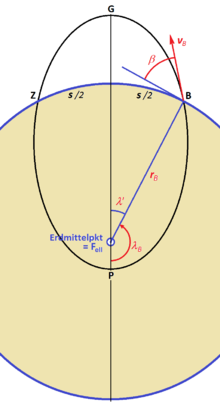Range (rocket)
The range of military short- , medium- and long-range missiles is understood as the distance between points on the earth's surface that the missile can cover as far as possible but safely controlled. In the case of anti-aircraft missiles , on the other hand, the range relates to an inclined distance with a sufficient probability of being hit.

Most of these missiles are classified as ballistic missiles ; H. after burnout of the rocket motor to follow a ballistic trajectory . In contrast to the propulsion phase, this is only influenced by gravity and air resistance .
In the case of long-range or ICBMs , on the other hand, a second propulsion phase can come before the end of the trajectory, which is intended to increase target accuracy . However, re-ignition of the drive is only possible with liquid rockets , not solid rockets . For controllable warheads, see Maneuverable reentry vehicle .
Typing of military missiles
- As a short-range missiles (Short Range Ballistic Missile, SRBM) missiles are referred km with ranges to 150 bar. Your launch devices can be stationary or mobile (vehicle, ship, airplane).
- As a medium-range missiles (Medium Range Ballistic Missile, MRBMs) are usually referred to those warheads (nuclear or conventional) km over distances 1000-2700 can wear to the finish. Their launch devices can be stationary ( missile silo ) or mobile (vehicle, ship, aircraft).
- Intermediate Range Ballistic Missile ( IRBM ) are ballistic medium-range missiles with ranges from 2700 to 5500 km. Their launchers can also be stationary or movable. Soviet systems were u. a. the SS-5 and SS-20.
- As ICBMs (Intercontinental Ballistic Missile, ICBM) apply after II SALT all military missiles with a range of more than 5500 km, -Vertrag regardless of the warhead (nuclear or conventional). Their launch systems are permanently installed (mostly underground silos) or mobile (on submarines , vehicles, larger ships or aircraft carriers ).
- These fly to their destination after leaving the earth's atmosphere on an elliptical trajectory and exist
- from the propulsion stage and a re-entry warhead or
- multiple re-entry warheads and the mother warhead (Post-Boost-Vehicle, PBV ).
- These fly to their destination after leaving the earth's atmosphere on an elliptical trajectory and exist
Influencing variables for the range
The most important parameter for the range of ballistic missiles is
- the burn closure or final velocity . It results from the burning time and the average acceleration in the propulsion phase, which in turn depends on the thrust of the rocket motor, the take-off weight and the empty weight of the missile.
Further influencing factors are
- the launch angle , the optimum of which for short-range missiles with Mach 2–5 is slightly over 50 ° (without braking air it would be 45 °, see trajectory parabola and ballistics ),
- as well as air resistance , the overall effect of which depends on the altitude .
- In the case of medium-range missiles, the take-off is steeper (see sketch above) in order to soon reach thinner layers of air; only then does the angle become flatter. The optimum flight altitude during which the rocket flies horizontally for a short time is heavily dependent on the planned range.
In contrast, ICBMs practically fly outside of the earth's atmosphere after a burnout , where they briefly move in an elliptical orbit around the earth , analogous to a satellite launch .
ICBM trajectory

The further the orbit ellipse moves away from the earth's surface, the greater the range. It depends on speed, altitude and orbital inclination at the end of firing of the rocket motor (see rocket equation ). The burning speed is around 6 to 7 km / s, close to the 1st cosmic speed for low satellite orbits. A change of 1%, however, already causes 500–1000 km in the flight distance. By controlling during the drive phase, however, 0.01% has long been achieved. For the last flight segment, the re-entry into the lower atmosphere, the laws of ballistics are again effective, as are the parameters of a possible second drive or control phase.
In the sketch opposite, the rocket has reached the end of combustion at point B and is moving upwards at the speed v B at the angle β . From there it follows the force-free orbit of a Keplerellipse with the perigee P (near the center of the earth) and the apogee in G , where it reaches its peak height and lowest speed. Then an ever faster descent begins until the ellipse intersects the earth's surface (or the denser air layers) at target point Z.
According to R.Giese, the maximum range results for a starting angle β max , which is determined by the ratio x of the flame retardation speed v B to the circular path speed v K :
cos² βmax = 1 / (2 - x²)
At v K = 7.91 km / s and x = 0.707 (v B = 5.58 km / s) the result is β max = 35.2 °. This results in a peak height of 870 km and a range s = 4,300 km.
Literature and web links
- Richard Heinrich Giese : Space Research Volume I, Chapter IV Application of Space Flight Mechanics . BI university paperback 107 / 107a, Bibliogr.Inst., Mannheim 1966
- G. Hauck: The flight of unguided projectiles and rockets. An introduction to external ballistics . Military publishing house of the GDR, Berlin 1990typo
- Nuclear weapons from A to Z, here z. B. ICBM
- Long-Range Missiles: Who Has the Biggest? Who can go the furthest? , Die Welt May 20, 2012